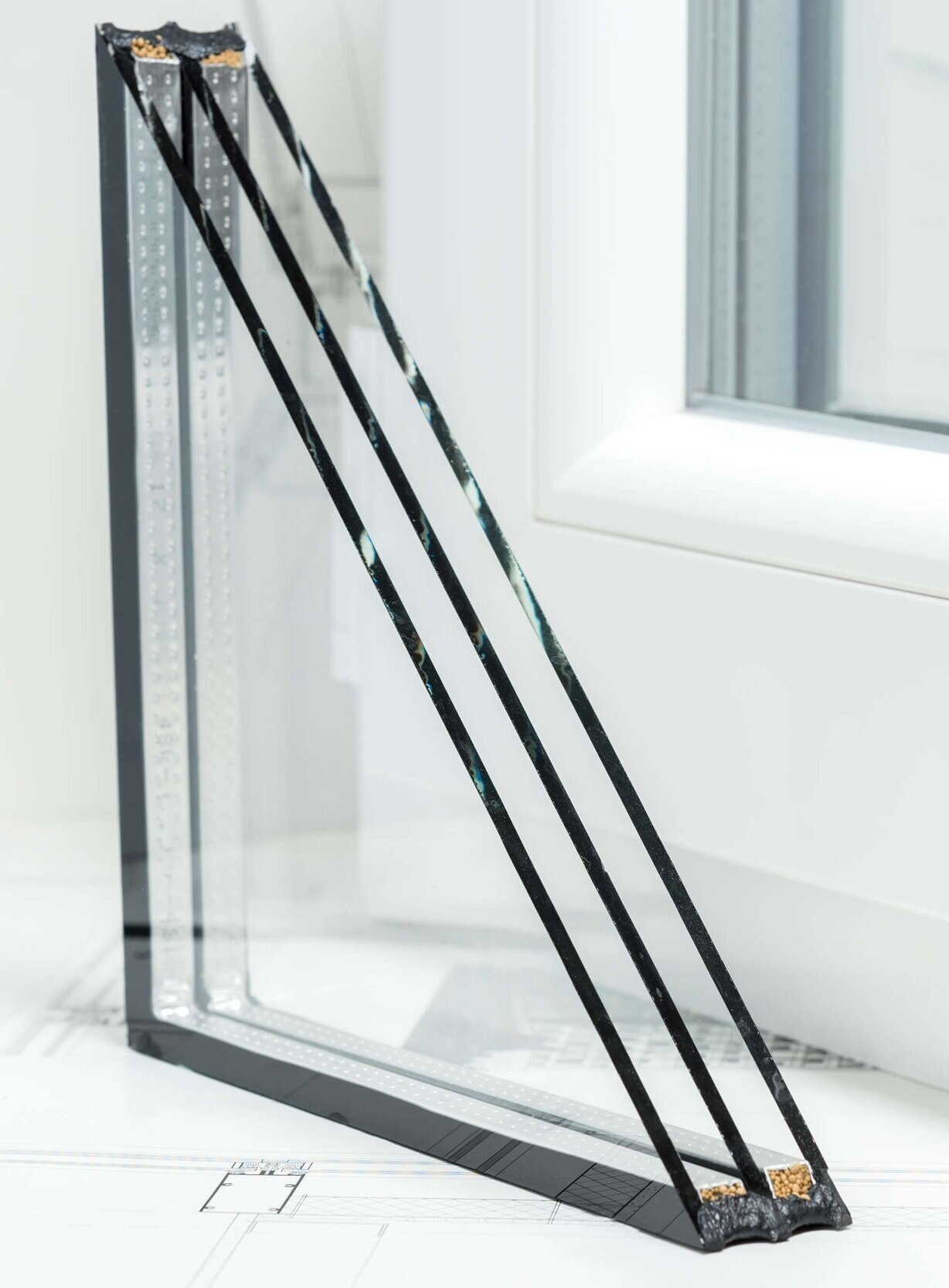Why does window glazing matter?
Glazing is one of the most important drivers of window performance.
It’s easy to forget about the invisible: glass is one of the most important drivers of window performance, but it’s often overlooked in the buying decision.
In this blog post, you’ll learn why window glazing matters and what glazing performance criteria to look out for.
We’ll also tell you how these factors translate into the final glazing product, the so called glazing package, and and show you how to incorporate glazing performance into your window buying decision.
What are performance criteria for window glazing?
First, let’s consider the two most basic functions of the glazing: creating a physical barrier and letting light pass from the exterior to the interior. Everything that matters about window glazing performance relates to these very fundamental properties.
As a physical barrier, the glazing contributes both to the thermal performance of a window and its impact resistance.
The better the glazing insulates the interior from the exterior, the less energy is required to maintain a constant temperature difference between the inside and the outside. This aspect of energy efficiency is referred to as thermal performance. The thermal performance is represented by the U-value, which gives the thermal transmittance per hour and per square foot. The lower the U-value, the less thermal energy is transmitted through the glazing. This means a lower U-value equates to better thermal efficiency. (Experts: don’t worry, we’ll cover solar heat gain in a little bit).
The impact resistance of glazing does not come with a standard measure, but there are a few things to keep in mind:
In general, the thicker the pane of glass, the less easily the pane will breaks.
If the glass is toughened using the thermal tempering process of heating and rapid cooling and/or if the glass is by laminated, it’s considered safety glass. Tempered glass is stronger, more resistant to breakage, and when it does break, it will ‘crumble’ into smaller, non-jagged pieces. Laminated glass has a thin, plastic lamination material applied to its surface which ensures the glass pane holds together if it shatters. The combination of tempering and laminating provides the best protection against glass breakage and the resultant glass debris.
Thermal efficiency and impact resistance don’t always set the same priorities for window glazing if the maximum thickness is limited. For example, a massive, one inch thick single pane of glass breaks less easily than a set of two quarter inch glass panes with half an inch of gas in between. (That combination of glazing panes and gas is called a glazing package; we’ll provide more details about that in a moment.) However, a glazing package will certainly perform better from a thermal efficiency standpoint.
Besides its properties as a physical barrier, the glazing’s light transmittance represents the other fundamental aspect of its performance.
The glazing’s light transmittance matters in two ways. First, it affects how much heat is generated by the sun on the interior of a home or building, an effect known as solar heat gain. Second, it affects how much visible light is able to pass through the glazing.
Solar heat gain is often represented by a measure called the Solar Heat Gain Coefficient (SHGC). SHGC values for glazing range between 0 and 1, where the higher the value, the more solar energy passes through the glazing, and the more heat is generated by it.
Whether a higher or lower SHGC value is desirable depends on where you live. If you’re in a cold region of the United States, you would want to get as much of the solar heat gain as possible in order to reduce the amount of energy that you spend on heating. If, however, you’re in a hot part of the country, you would want to have a low SHGC so that your air conditioning doesn’t have to work so hard.
The amount of visible light that is able to pass through the glass is represented by the so called Visible Transmittance (VT). The higher the VT, the more transparent the glazing appears and the more daylighting is allowed inside the home or building.
Solar heat gain and visible transmittance are both forms of light transmittance. The only difference is that the solar heat gain refers to the light frequencies that cause a heat gain on the interior, while visible transmittance refers to the frequencies that the human eye can process.
This serves you well if you’re in a cold climate and want both a lot of daylight and a lot of solar heat gain on the interior. Your goals align as you simply want your glazing to block as little of the light as possible, no matter what frequency.
If, however, you’re in a hot climate, you probably still want a lot of daylight to pass through while reducing the solar heat gain as much as possible. In those cases, special coatings for the glazing panes can filter out the relevant light frequencies that create solar heat gain while leaving as much visible transmittance as possible.
Still, in all cases, glazing with a lower solar heat gain will also have a lower visible transmittance. That’s because the light frequency bands that create solar heat gain overlap with the frequency bands that make up the visible spectrum of light.
What is a glazing package?
Cross section of triple glazing package
Now that you know what makes up the performance aspects of glazing, let’s look at how the final glazing product is optimized to maximize the performance.
We mentioned something called a “glazing package” earlier. It’s made of at least two glazing panes with spacers in between.
The spacers are located around all edges of the glazing package so that a sealed chamber is created between the panes. The chamber is filled with a gas that has a low thermal transmittance, usually Argon. By stacking up a glass pane, a layer of insulating gas and another glass pane, a glazing package achieves a low U-value (thermal transmittance) without sacrificing visible transmittance (because the gas has almost no impact on it). Triple glazing is the same thing, just with another layer of gas and another glass pane added.
The break resistance of the glazing package can be increased by tempering or laminating one or all glazing panes. To reduce the SHGC of the glazing package, coatings that filter out as much of the relevant light frequencies as possible can be added to the inward facing sides of the glazing panes.
Your windows most likely already have a glazing package with double glazing. When you take a closer look, you can probably see the individual panes with spacers around the frame in between. The spacers usually appear silver or black. If you have triple glazing, you’ll see three individual panes with two sets of spacers in between. Due to the additional layer of insulation, triple glazing has a lower thermal transmittance (i.e. a lower U-value) than double glazing made from the same components.
Not every window profile can house a triple glazing package as they it is thicker than standard double glazing. Learn more about that aspect of window design in our blog post about European windows.
How do you incorporate your knowledge about glazing into your window-buying decision?
Whether you’re buying a European window or a standard double hung window, you’ll need to start with the same question when exploring your glazing options: Where is my project located? As we explained earlier, your location makes a big difference when choosing the right glazing.
Window glazing performance recommendation per climate zone. Source: PHIUS
In cold climates you want a very low U-value (i.e. a low thermal transmittance to insulate your interior from the cold exterior), as well as a high solar heat gain and a high visible transmittance. In hot climates, you still want a low U-value, but you also want the solar heat gain to be low to reduce the load in your air conditioning.
Again, glazing with a lower solar heat gain also has a lower visible transmittance. You’ll need to find the right balance between your energy efficiency goals and the visible transmittance you’re looking for.
With your location in mind and an understanding of how the different performance criteria of glazing relate to each other, you can start researching the optimal glazing for your application.
Government agencies and non-profits that release glazing recommendations for different climate zones are a good place to start.
The Passive House Institute US (PHIUS) offers a free chart of performance recommendations both for glazing and fully assembled windows on their website. Making sure that the glazing of your windows meets these recommendations will ensure the glazing performance meets your needs.
If you want to take it a step further and go with the gold standard in choosing the right glazing for your project, it’s time to sit down with your architect. As you can probably imagine, it matters where the glazing is installed. A huge window on the south side of the building with no shade has a very different impact than the same window under a pergola on the north side of the building.
These aspects of glazing performance can only be considered by modeling your building and calculating things like the solar heat gain based on the actual location, orientation and shading of your building. We’re happy to put you in touch with architects and engineers that can provide these services!
About Bauwerk Building Solutions
Bauwerk is a multinational business that connects US clients to an extensive network of European manufacturers of windows, doors, curtain wall systems, and more. We specialize in innovative and refined building products of the highest quality. Our offices are located in Charlotte, NC and Berlin, Germany.



